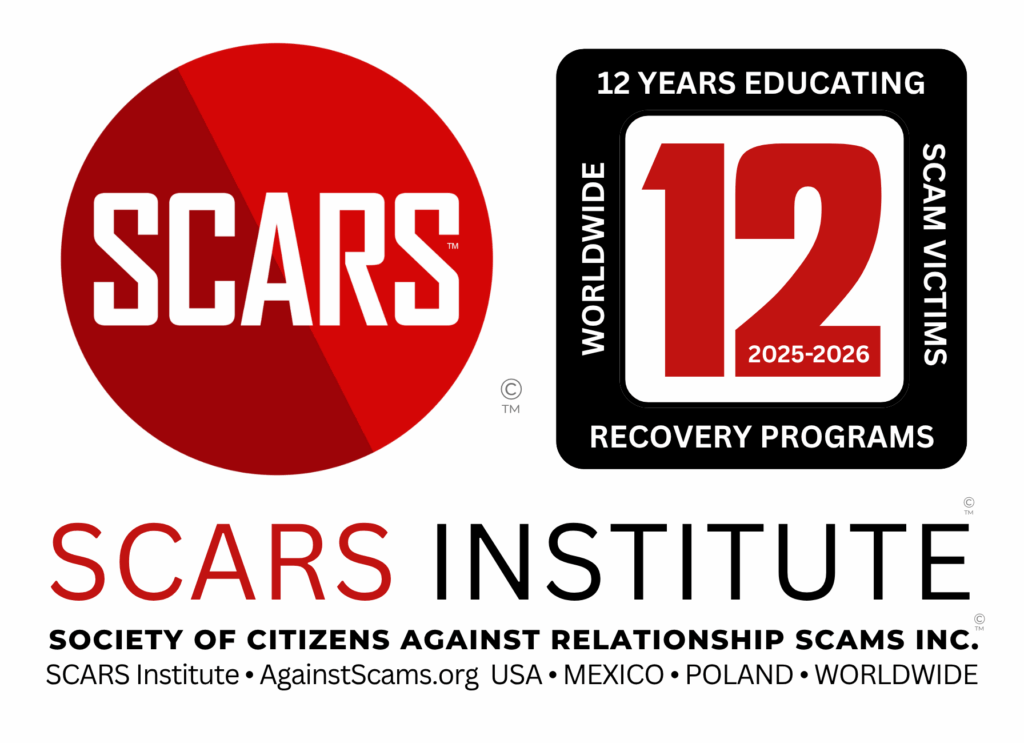
Comprehending the Incomprehensible
The Scam Victims’ Journey to Understand Why This Happened to Them
Primary Category: Recovery Psychology / Recovery Philosophy
Author:
• Tim McGuinness, Ph.D., DFin, MCPO, MAnth – Anthropologist, Scientist, Polymath, Director of the Society of Citizens Against Relationship Scams Inc.
Author Biographies Below
About This Article
The journey to comprehend the incomprehensible for scam victims is a profound and confusing experience. Victims grapple with the betrayal of trust, the illusion of control, and the paradox of emotional investment, which leaves them feeling disoriented and powerless. Understanding the psychology of scammers and the tactics they employ, such as gaslighting and emotional labor, helps victims separate their self-worth from the scammer’s actions. The path to comprehension is not linear but spiral, requiring patience, self-compassion, and a willingness to explore the complexities of their emotions and thoughts. By educating themselves, seeking support, and engaging in reflective practices, victims can gradually unravel the mysteries of their experience and find a sense of control and healing. This journey is unique to each individual, and embracing the spiral nature of growth and understanding can lead to resilience and a deeper appreciation of one’s own strength and capacity for healing.
Note: This article is intended for informational purposes and does not replace professional medical advice. If you are experiencing distress, please consult a qualified mental health professional.

Comprehending the Incomprehensible: The Scam Victims’ Journey to Understand Why This Happened to Them
Incomprehensible
As a scam victim, you will find yourself grappling with a profound sense of confusion and incomprehension. This is normal and natural, and is typically psychological dissonance. The deceptive nature of scams can leave you questioning your judgment, your perceptions, and even your reality. It’s natural to feel overwhelmed by the complexity of your experience and the seemingly incomprehensible actions of those who betrayed your trust. But know this: you are not alone in your struggle, and there are pathways to understanding this that can help you make sense of the incomprehensible.
The first step in comprehending the incomprehensible is to shake loose your cognitive biases and logical fallacies and accept that, for the moment, it is incomprehensible. True understanding only emerges when we accept that we do not understand. Biases, assumptions, and fallacies only block the way.
The Mystery of Betrayal
One of the most perplexing aspects of being a scam victim is the betrayal of trust; this is the prime engine of your trauma. You placed your faith in someone, perhaps even fell in love, only to discover that it was all a carefully crafted illusion. The incomprehensibility of this betrayal leaves you feeling shattered and disoriented. How could someone be so cruel, so calculated in their deception? The answer lies in understanding the psychology of the scammer.
Scammers often have a unique set of traits that enable them to manipulate and deceive. They may be highly intelligent, charming, and adept at reading people’s emotions and vulnerabilities. Their ability to create a false narrative is not a sign of your weakness but a testament to their skill in manipulation. By recognizing this, you can begin to separate your self-worth from the scammer’s actions and make this understandable. You were a target, not a fool or stupid, and your trust was exploited by someone with a particular set of skills and intentions.
The Illusion of Control
Another incomprehensible aspect of scams is the sense of control that scammers exert over their victims. You may wonder how you could have been so easily manipulated, how your own agency seemed to dissolve in the face of their influence. This feeling of powerlessness is a common reaction and leads to the betrayal trauma that is particularly pronounced in scam victims.
To comprehend this, consider the concept of “gaslighting,” a form of psychological manipulation where the scammer creates a false narrative and makes you question your own reality. Gaslighting can be so subtle and insidious that you may not even realize it’s happening until it’s over. Scammers use this technique to gain control, making you dependent on their version of events and eroding your confidence in your own perceptions.
Understanding gaslighting is a crucial step in reclaiming your sense of control. By educating yourself about these tactics, you can recognize the patterns of manipulation and begin to trust your own instincts again. Remember, your emotions are valid, and you have the power to challenge the false narratives imposed by the scammer.
The Paradox of Emotional Investment
The emotional investment you made in the scam can also feel incomprehensible. How could you have poured so much of yourself into something that turned out to be a lie? An illusion? This paradox is a natural consequence of the scammer’s ability to create a deep emotional connection, often exploiting your desire for love, companionship, or financial security.
To make sense of this, consider the concept of “emotional labor.” Scammers invest significant effort into creating a convincing facade, mirroring your emotions and desires to make you feel understood and valued. This emotional labor can be so convincing that it blurs the lines between reality and fiction, making it difficult to distinguish a genuine connection from manipulation.
Comprehending this paradox involves acknowledging the skill with which scammers operate and the genuine emotions they evoke in their victims. Your emotional investment was not a sign of weakness but a testament to your capacity for love and trust. By recognizing the complexity of your emotional response, you can begin to heal and rebuild your ability to form healthy, authentic connections.
The Labyrinth of Cognitive Dissonance
Cognitive dissonance, the mental discomfort experienced by holding two or more contradictory beliefs, values, or ideas, is a common experience for scam victims. You may struggle to reconcile the person you thought you knew with the reality of their deception. This internal conflict can create a labyrinth of confusing thoughts and emotions, making it difficult to find your way to understanding.
To navigate this labyrinth, start by acknowledging the dissonance without judgment – name it, don’t blame it. It’s okay to feel confused and conflicted; these feelings are a natural response to the trauma you’ve experienced. Next, break down the contradictory beliefs into smaller, more manageable parts. Ask yourself questions like, “What evidence do I have for each belief?” and “How do these beliefs make me feel?”
By examining the dissonance objectively, you can begin to resolve the internal conflict and gain a clearer understanding of your experience. Remember, healing is a journey, and it’s okay to take small steps as you work through the complexities of your emotions and thoughts.
The Enigma of Self-Blame
Self-blame is a pervasive and incomprehensible emotion for many scam victims. You may find yourself asking, “How could I have been so naive?” or “Why didn’t I see the signs?” This enigma of self-blame can be particularly challenging to unravel, as it involves confronting your own vulnerabilities and perceptions.
To comprehend and overcome self-blame, start by practicing self-compassion. Treat yourself with the same kindness and understanding you would offer to a dear friend. Recognize that being a victim of a scam does not define your intelligence or worth. Everyone is susceptible to manipulation, and your experience is a testament to your capacity for trust and empathy.
Additionally, seek support from others who have gone through similar experiences. Hearing their stories and understanding their journeys can provide a new perspective and help you see that you are not alone in your struggle. Support groups, therapy, and online communities can offer a safe space to share your feelings and gain insights from those who have walked a similar path.
The Puzzle of Trust
Rebuilding trust after a scam can feel like solving an impossible puzzle. You may wonder how you can ever trust again, especially when the very foundations of your trust have been shaken, if not destroyed. This puzzle is a natural part of the healing process, and comprehending it involves understanding the different types of trust and how to rebuild them.
Start by differentiating between types of trust, such as emotional, physical, and intellectual trust. Recognize that just because one type of trust has been broken, it doesn’t mean all types are irreparably damaged. Begin by rebuilding trust in small, manageable steps. This might involve setting boundaries, communicating more openly and honestly, and taking time to get to know new people before fully trusting them.
Remember, trust is a two-way street, and it’s okay to be cautious as you rebuild. Surround yourself with people who respect your boundaries and support your healing journey. Over time, as you experience positive interactions and rebuild your sense of security, you will find that trust can be restored, even after profound betrayal.
The Riddle of Healing
Healing from the betrayal trauma of a scam is a complex and often incomprehensible journey. You may find yourself asking, “Will I ever feel whole again?” or “How can I move forward when the pain is so profound?” This riddle of healing involves understanding that healing is not a linear process but a series of steps, setbacks, and breakthroughs. The journey is a spiral, not a direct path.
To comprehend and embrace your healing journey, start by setting realistic expectations. Healing takes time, and it’s okay to have good days and bad days. Celebrate your progress, no matter how small, and be patient with yourself as you navigate the ups and downs.
Additionally, explore different healing modalities that resonate with you. This might include therapy, support groups, creative outlets, or mindfulness practices. Each person’s healing journey is unique, and what works for one may not work for another. Trust your guides and professionals, and be open to trying new approaches as you discover what brings you comfort and growth. Remember, you are not an expert at recovering.
The Mystery of Resilience
Resilience, the ability to bounce back from adversity, can feel like a mystery, especially when you’re in the midst of your healing journey. You may wonder, “How can I be strong when I feel so broken?” or “Will I ever regain my sense of self?” This mystery involves understanding that resilience is not about being invincible but about finding the strength to keep moving forward, even in the face of profound challenges and a life full of chaos.
To comprehend and cultivate resilience, start by acknowledging your existing strengths and resources. You have already shown remarkable resilience by surviving the trauma of the scam and seeking ways to heal. Next comes learning to manage. Build on this foundation by setting small, achievable goals and celebrating each step forward.
Additionally, connect with your support network, whether it’s friends, family, or a community of fellow scam survivors such as at SCARScommunity.org. Sharing your experiences and drawing strength from others can provide a powerful boost to your resilience. Remember, you are not alone, and your ability to heal and grow is greater than you may realize.
The Nature of the Journey to Comprehend
As you embark on the journey to comprehend the incomprehensible, it’s essential to understand that this path is not a straight line but a spiral. Imagine setting out on a winding road that curves and loops, bringing you closer to your destination with each revolution. This metaphor of the spiral journey is important for understanding the nature of your healing and growth.
When you try to approach comprehension head-on, you may find yourself facing an impassable wall of dissonance. The conflicting emotions, thoughts, and experiences can create a barrier that seems insurmountable. You might feel stuck, as if no matter how hard you try, you can’t break through to a place of understanding. This is a common experience, and it’s a sign that you’re trying to force a linear solution onto a spiral problem.
Alternatively, you might find yourself in a circle, repeating the same thoughts and emotions without making any progress. This circular pattern can be frustrating and disheartening, as it feels like you’re running in place, never getting closer to comprehension. The key to breaking free from this cycle is to embrace the spiral nature of your journey.
The spiral journey allows you to approach comprehension from different angles and depths. With each loop, you gain new insights and perspectives that build upon your previous understanding. It’s a process of gradual revelation, where the incomprehensible slowly becomes comprehensible as you integrate new knowledge and experiences.
Think of it like peeling an onion. Each layer you remove reveals a new depth, and while it might seem like you’re not making much progress at first, each layer brings you closer to the core. Similarly, as you spiral down, you’re peeling back the layers of your experience, gaining a deeper and more nuanced understanding with each revolution.
Embracing the spiral journey also means being patient with yourself. Healing and comprehension are not rushed processes, and trying to force them can lead to more frustration and dissonance. Allow yourself the time and space to explore your thoughts and emotions at your own pace. Take the time to learn from the experts. Trust that with each loop, you’re moving closer to a place of understanding and peace.
Also, the spiral journey is not just about gaining knowledge but also about integrating that knowledge into your being. It’s about allowing the insights and revelations to transform you from the inside out. This integration is a gradual process, and it’s okay if you don’t fully comprehend everything at once. The spiral allows you to digest and absorb the information in manageable pieces, making it more accessible and meaningful.
As you spiral down, you may also encounter setbacks and challenges. These are a natural part of the journey and should not be seen as failures. Instead, view them as opportunities to deepen your understanding and strengthen your resilience. Each challenge you overcome adds another layer to your comprehension, making you more equipped to handle future obstacles.
Concrete Steps to Begin Your Spiral Journey
Educate Yourself with Essential Knowledge:
Step 1: Learn the Basics. Start by visiting www.ScamVictimsSupport.org to gain an understanding of what new victims need to know. This resource provides foundational information that can help you contextualize your experience and understand the common patterns and tactics used by scammers. By learning about the basics, you’re laying the groundwork for your spiral journey, giving yourself a solid starting point from which to explore deeper layers of comprehension.
Enroll in the SCARS Institute Scam Survivor’s School:
Step 2: Engage in Daily Learning. Enroll in the free SCARS Institute Scam Survivor’s School, where information is provided in small, digestible amounts daily. This approach aligns with the spiral nature of your journey, allowing you to absorb and integrate knowledge gradually. Each day, you’ll receive new insights and perspectives that build upon what you’ve already learned, helping you to spiral deeper into understanding without feeling overwhelmed.
Join a Support Community:
Step 3: Connect with Others at SCARScommunity.org. Seek out support groups or online communities where you can share your experiences and learn from others who have gone through similar journeys. Engaging with a community provides you with a safe space to explore your thoughts and emotions, and it offers the opportunity to gain diverse perspectives that can enrich your comprehension. Remember, you’re not alone, and the collective wisdom of the community can be a powerful tool on your spiral path.
Practice Mindfulness and Reflection:
Step 4: Cultivate Self-Awareness. Incorporate mindfulness and reflection practices into your daily routine. This might include journaling, meditation, or simply taking time each day to sit quietly and observe your thoughts and emotions. Mindfulness helps you stay present and non-judgmental, allowing you to notice the patterns and insights that emerge as you spiral down. Reflection enables you to process your experiences and gain a deeper understanding of your inner world.
Seek Professional Guidance:
Step 5: Consult with Experts. Consider working with a therapist or counselor who specializes in trauma and scam recovery. Professional guidance can provide you with personalized strategies and tools to navigate your spiral journey. A therapist can help you unpack your experiences, challenge cognitive dissonance, and develop a greater sense of control and comprehension over your emotions and thoughts. Members of the SCARS Institute Support Community are provided with initial therapy at no cost (while available).
Explore Creative Outlets:
Step 6: Express Yourself Creatively. Engage in creative activities such as writing, painting, or music as a means of expressing and processing your experiences. Creative outlets offer a unique way to explore the incomprehensible, allowing you to externalize your thoughts and emotions in a tangible form. This can provide new insights and help you integrate your experiences in a way that feels authentic and meaningful to you.
Set Small, Achievable Goals:
Step 7: Break Down Your Journey. Instead of trying to comprehend everything at once, set small, achievable goals for yourself. Break down your journey into manageable steps, focusing on one aspect of your experience at a time. Celebrate each small victory and use it as motivation to continue spiraling down, knowing that each step brings you closer to a place of understanding and healing.
Embrace the Unknown:
Step 8: Be Open to Surprises. Remember that the spiral journey is unpredictable, and new insights and revelations may come from unexpected places. Stay open to the unknown and be willing to adapt your path as you go. Trust that the journey itself is a form of comprehension, and that by embracing the spiral, you’re allowing yourself the space to grow and heal in ways you may not have anticipated.
By following these steps, you’re embarking on a spiral journey that honors the complexity and depth of your experiences. Remember, comprehension is not a destination but a process, and by spiraling down, you’re giving yourself the time and space to integrate new knowledge and perspectives in a way that feels true to you. Trust in the journey, and know that with each loop, you’re moving closer to a place of understanding, resilience, and healing.
Conclusion
Comprehending the incomprehensible is a journey of self-discovery, healing, and growth. As a scam victim, you are navigating a complex landscape of emotions, thoughts, and experiences that can feel overwhelming and confusing. But by understanding the psychology of scammers, the nature of betrayal, and the complexities of your own emotional response, you can begin to make sense of the seemingly incomprehensible.
Remember, healing is a personal and unique journey, and there is no right or wrong way to process your experiences. Be kind to yourself, seek support when you need it, and trust in your ability to grow and thrive, even in the face of profound trauma. You have the strength and resilience to comprehend the incomprehensible and emerge from this experience with a deeper understanding of yourself and the world around you.

Glossary
- Acceptance window — This term describes the small mental space where a person can admit not understanding yet without blaming themselves. It lowers defensiveness and opens room for learning. Working inside this window prevents snap judgments that stall recovery.
- Agency restoration — This refers to the step-by-step return of personal choice after manipulation. Small, safe decisions rebuild confidence. Tracking wins in a notebook helps the mind recognize progress.
- Attachment injury — This means the wound created when trust is broken by someone who posed as caring. The hurt reaches identity and safety, not only money. Naming it as an attachment injury guides the kind of help that heals.
- Betrayal trauma — This describes trauma caused by harm from a trusted person. The shock disrupts memory, sleep, and judgment. Gentle routines and trauma-informed counseling support stabilization.
- Boundary reconstruction — This is the process of resetting what access others have to time, money, and attention. Written rules and default pauses protect energy while trust is rebuilt. Clear boundaries reduce repeat victimization.
- Cognitive reframing — This skill replaces self-blame thoughts with accurate statements. The person learns to separate the scammer’s choices from their own worth. Reframing reduces shame and improves decision quality.
- Complicity fantasy — This term captures the false belief that the victim agreed with the scam. It grows from hindsight and fear of judgment. Evidence review and outside perspectives correct the story.
- Control recovery — This is the gradual return of a sense of control over daily life. Checklists, calendars, and clear next steps calm the nervous system. Control grows fastest through simple, repeatable actions.
- Covert coercion — This describes pressure applied through praise, secrecy, or staged crises rather than direct threats. It narrows choices without open force. Spotting these patterns early prevents deeper harm.
- Critical incident timeline — This is a dated list of key messages, payments, and turning points. The record supports police reports and insurance claims. It also helps the mind see how manipulation unfolded.
- Deception grooming — This refers to the early phase where scammers test boundaries, mirror values, and build dependence. The goal is consent without clarity. Recognizing grooming signs allows an earlier exit.
- Dignity repair — This means rebuilding a sense of worth after humiliation. Respectful routines, clean spaces, and supportive company reinforce dignity. Small acts of self-care count as evidence of value.
- Disconfirmation ritual — This is a short routine that tests a strong belief against outside proof. It might include a second source and a 24-hour wait. Regular use weakens false certainty.
- Emotional granularity — This skill names feelings with precision rather than using only “bad” or “sad.” Specific labels reduce overwhelm and guide the right coping tool. Practice grows through a feelings list.
- Emotional labor mirroring — This describes how scammers echo hopes and fears to win trust. The mirror looks caring but is strategic. Learning to verify rather than vibe-check protects the heart.
- Forgiveness as release — This form of forgiveness means letting go of self-poisoning resentment, not excusing a crime. It can wait until safety and accountability are in place. Release frees energy for recovery work.
- Forensic documentation — This is the organized saving of screenshots, receipts, and chats. Files are labeled, dated, and backed up. Good documentation strengthens reports and shortens investigations.
- Gaslighting — This manipulation makes a person doubt their memory and judgment. Confident lies are paired with selective facts until reality feels uncertain. Written records and trusted witnesses break the spell.
- Grief mapping — This tool lists losses beyond money, such as trust, time, and plans. Seeing the whole map validates pain and guides support. Each area can then receive its own repair plan.
- Identity reconstruction — This process rebuilds roles and self-story after betrayal. New routines, learning, and safe relationships form the base. The person becomes more than the crime that hit them.
- Insight pacing — This practice spreads hard truths across time so the body can keep up. Short sessions and planned breaks prevent shutdown. Pacing keeps healing steady rather than explosive.
- Meaning-making practice — This refers to finding lessons and values without blaming the self. Journaling and guided reflection connect pain to purpose. Meaning raises motivation to continue recovery.
- Moral injury — This injury arises when someone’s core values feel broken by deceit. Shame and anger often mix with grief. Value-focused counseling and community repair help restore integrity.
- Narrative coherence building — This is the work of turning fragments into a clear story. Coherence lowers confusion and supports legal and financial steps. Telling the story to a safe listener strengthens recovery.
- Narrative exposure writing — This technique places events on a timeline with sensory details and facts. Writing organizes memory and reduces intrusions. It pairs well with therapy and documentation needs.
- Nervous system literacy — This means understanding body signals like a racing heart or numbness. Knowledge turns symptoms into useful data. Simple grounding skills can then match each state.
- Reality testing — This habit checks strong claims against neutral evidence. It includes direct calls to institutions and independent records. Reality testing replaces guesswork with facts.
- Recovery spiral — This model shows healing as circling back with a deeper understanding rather than moving in a straight line. Returns to old topics are signs of growth, not failure. The spiral normalizes setbacks.
- Relational safety plan — This plan lists who is safe to contact, what to share, and what to keep private. It includes exit phrases for unwanted conversations. A clear plan protects energy and trust.
- Self-compassion practice — This is the daily choice to treat oneself with fairness and care. Warm self-talk reduces shame and supports problem-solving. Compassion makes persistence possible.
- Self-efficacy rebuilding — This refers to restoring belief in one’s ability to act and succeed. Small goals with quick feedback create momentum. Confidence returns through doing, not only thinking.
- Shame resilience — This skill set helps a person face shame without hiding or lashing out. Naming the feeling, checking facts, and seeking kind contact weaken its grip. Resilience grows through practice.
- Social proof trap — This trap occurs when fake testimonials and follower counts make lies look true. Volume pretends to be validation. Independent verification breaks the spell.
- Staged disclosure — This method shares parts of the story in planned steps with chosen people. It protects privacy while gaining support. Each stage checks readiness and safety.
- Trauma-informed boundaries — These are limits set with awareness of triggers and capacity. Clear language and consistent follow-through keep relationships safe. Boundaries are a health tool, not a punishment.
- Trauma load — This term sums current stressors that strain coping, including money, legal tasks, and memories. High load predicts symptom spikes. Reducing small stressors lowers overall weight.
- Trust calibration — This is the careful adjustment of how much access others receive. Trust grows with verified behavior over time. Calibration prevents the all-or-nothing swings that follow betrayal.
- Values clarification — This exercise identifies what matters most after the loss. Choices then align with those values. Clarity simplifies decisions and reduces regret.
- Victim-blaming myth — This myth says the target caused the crime by being naive or greedy. It hides offender responsibility and delays help. Calling it a myth protects dignity and improves reporting.
- Vicarious resilience — This benefit comes from seeing other survivors heal. Their progress models skills and hope. Joining supportive communities increases this effect.
Author Biographies
Please Rate This Article
Please Leave Us Your Comment Below
Also, tell us of any topics we might have missed.
-/ 30 /-
What do you think about this?
Please share your thoughts in a comment above!
ARTICLE RATING
TABLE OF CONTENTS
- The Scam Victims’ Journey to Understand Why This Happened to Them
- Comprehending the Incomprehensible: The Scam Victims’ Journey to Understand Why This Happened to Them
- Incomprehensible
- The Mystery of Betrayal
- The Illusion of Control
- The Paradox of Emotional Investment
- The Labyrinth of Cognitive Dissonance
- The Enigma of Self-Blame
- The Puzzle of Trust
- The Riddle of Healing
- The Mystery of Resilience
- The Nature of the Journey to Comprehend
- Concrete Steps to Begin Your Spiral Journey
- Conclusion
- Glossary
CATEGORIES
U.S. & Canada Suicide Lifeline 988
![NavyLogo@4x-81[1] Comprehending the Incomprehensible: A Journey to Understand for Scam Victims - 2025](https://scamsnow.com/wp-content/uploads/2025/04/NavyLogo@4x-811.png)
ARTICLE META
One Comment
Leave A Comment
Important Information for New Scam Victims
- Please visit www.ScamVictimsSupport.org – a SCARS Website for New Scam Victims & Sextortion Victims.
- SCARS Institute now offers its free, safe, and private Scam Survivor’s Support Community at www.SCARScommunity.org – this is not on a social media platform, it is our own safe & secure platform created by the SCARS Institute especially for scam victims & survivors.
- SCARS Institute now offers a free recovery learning program at www.SCARSeducation.org.
- Please visit www.ScamPsychology.org – to more fully understand the psychological concepts involved in scams and scam victim recovery.
If you are looking for local trauma counselors, please visit counseling.AgainstScams.org
If you need to speak with someone now, you can dial 988 or find phone numbers for crisis hotlines all around the world here: www.opencounseling.com/suicide-hotlines
Statement About Victim Blaming
Some of our articles discuss various aspects of victims. This is both about better understanding victims (the science of victimology) and their behaviors and psychology. This helps us to educate victims/survivors about why these crimes happened and not to blame themselves, better develop recovery programs, and help victims avoid scams in the future. At times, this may sound like blaming the victim, but it does not blame scam victims; we are simply explaining the hows and whys of the experience victims have.
These articles, about the Psychology of Scams or Victim Psychology – meaning that all humans have psychological or cognitive characteristics in common that can either be exploited or work against us – help us all to understand the unique challenges victims face before, during, and after scams, fraud, or cybercrimes. These sometimes talk about some of the vulnerabilities the scammers exploit. Victims rarely have control of them or are even aware of them, until something like a scam happens, and then they can learn how their mind works and how to overcome these mechanisms.
Articles like these help victims and others understand these processes and how to help prevent them from being exploited again or to help them recover more easily by understanding their post-scam behaviors. Learn more about the Psychology of Scams at www.ScamPsychology.org
SCARS INSTITUTE RESOURCES:
If You Have Been Victimized By A Scam Or Cybercrime
♦ If you are a victim of scams, go to www.ScamVictimsSupport.org for real knowledge and help
♦ SCARS Institute now offers its free, safe, and private Scam Survivor’s Support Community at www.SCARScommunity.org – this is not on a social media platform, it is our own safe & secure platform created by the SCARS Institute especially for scam victims & survivors.
♦ Enroll in SCARS Scam Survivor’s School now at www.SCARSeducation.org
♦ To report criminals, visit https://reporting.AgainstScams.org – we will NEVER give your data to money recovery companies like some do!
♦ Follow us and find our podcasts, webinars, and helpful videos on YouTube: https://www.youtube.com/@RomancescamsNowcom
♦ Learn about the Psychology of Scams at www.ScamPsychology.org
♦ Dig deeper into the reality of scams, fraud, and cybercrime at www.ScamsNOW.com and www.RomanceScamsNOW.com
♦ Scam Survivor’s Stories: www.ScamSurvivorStories.org
♦ For Scam Victim Advocates visit www.ScamVictimsAdvocates.org
♦ See more scammer photos on www.ScammerPhotos.com
You can also find the SCARS Institute’s knowledge and information on Facebook, Instagram, X, LinkedIn, and TruthSocial
Psychology Disclaimer:
All articles about psychology and the human brain on this website are for information & education only
The information provided in this and other SCARS articles are intended for educational and self-help purposes only and should not be construed as a substitute for professional therapy or counseling.
Note about Mindfulness: Mindfulness practices have the potential to create psychological distress for some individuals. Please consult a mental health professional or experienced meditation instructor for guidance should you encounter difficulties.
While any self-help techniques outlined herein may be beneficial for scam victims seeking to recover from their experience and move towards recovery, it is important to consult with a qualified mental health professional before initiating any course of action. Each individual’s experience and needs are unique, and what works for one person may not be suitable for another.
Additionally, any approach may not be appropriate for individuals with certain pre-existing mental health conditions or trauma histories. It is advisable to seek guidance from a licensed therapist or counselor who can provide personalized support, guidance, and treatment tailored to your specific needs.
If you are experiencing significant distress or emotional difficulties related to a scam or other traumatic event, please consult your doctor or mental health provider for appropriate care and support.
Also read our SCARS Institute Statement about Professional Care for Scam Victims – click here
If you are in crisis, feeling desperate, or in despair, please call 988 or your local crisis hotline.
More ScamsNOW.com Articles
A Question of Trust
At the SCARS Institute, we invite you to do your own research on the topics we speak about and publish. Our team investigates the subject being discussed, especially when it comes to understanding the scam victims-survivors’ experience. You can do Google searches, but in many cases, you will have to wade through scientific papers and studies. However, remember that biases and perspectives matter and influence the outcome. Regardless, we encourage you to explore these topics as thoroughly as you can for your own awareness.























![scars-institute[1] Comprehending the Incomprehensible: A Journey to Understand for Scam Victims - 2025](https://scamsnow.com/wp-content/uploads/2025/04/scars-institute1.png)
![niprc1.png1_-150×1501-1[1] Comprehending the Incomprehensible: A Journey to Understand for Scam Victims - 2025](https://scamsnow.com/wp-content/uploads/2025/04/niprc1.png1_-150x1501-11.webp)

The end of fraud and many questions that torment us, many things that we do not understand. How can we comprehend the incomprehensible? The article provides eight steps that will help us solve this problem and make sense of what has been incomprehensible tous until now. A great article. Required reading for every survivor.